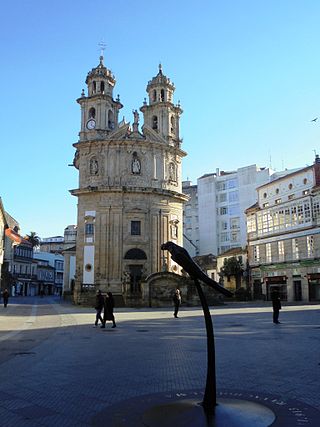
Pontevedra is a city in the autonomous community of Galicia, in northwestern Spain. It is the capital of both the Comarca and Province of Pontevedra, and the capital of the Rías Baixas. It is also the capital of its own municipality which is often considered an extension of the actual city.

The Alameda del arquitecto Sesmero, popularly known as la Alameda by the Pontevedrians, is an urban park located in the city centre of Pontevedra in Spain. It is the largest urban green space in the centre of Pontevedra city, together with the Palm Trees Park. The Alameda is located to the west of the old town, close to the old fishermen's quarter of A Moureira.

The Palm Trees Park, also known simply as Las Palmeras or As Palmeiras, is a public park in the heart of Pontevedra in Spain. It is the most representative and emblematic green area in the city centre, together with the Alameda de Pontevedra.

The Convent of St. Clare is a former cloistered convent of the Order of Poor Clares, located in the city centre of Pontevedra, Spain, precisely in Santa Clara Street, near the disappeared St. Clare Gate of the medieval city walls. Founded in 1271, the convent closed in 2017. In 2021 the City Council bought the building from the Order, and in 2023 it transferred it to the Provincial Deputation to become part of the Pontevedra Museum.

The Plaza de la Leña is a picturesque medieval square located in the heart of the old town of Pontevedra (Spain). It is the most typical medieval square in the historic centre and in Galicia.

The Praza da Ferrería is a large square located on the edge of the old town of Pontevedra (Spain), inside the old city walls. It is the main square of the old town and has an area of about 2,000 m2. It includes the small squares of the Estrella on the north side, the Orense square on the south side and the Casto Sampedro square on the east side, making a total of almost 5,000 m2.

The Gran Garaje is an Art Nouveau building dating from 1915, located in the city centre of Pontevedra, Spain.

Valle-Inclán, is a sculpture created by the Spanish sculptor César Lombera, located in Pontevedra (Spain). It is located in Plaza Méndez Núñez and was inaugurated on 26 June 2003.

The Plaza de Teucro is a square of medieval origin located in the heart of the old town of Pontevedra (Spain). It is the most harmoniously proportioned medieval square in the city.

The Plaza de la Verdura is a square of medieval origin located in the heart of the historic centre of Pontevedra (Spain). It is one of the liveliest medieval squares in the city.

Méndez Núñez Square is a square of medieval origin located in the heart of the historic centre of Pontevedra (Spain).

The historic centre of Pontevedra (Spain) is the oldest part of the city. It is the second most important old town in Galicia after Santiago de Compostela, and was declared a historic-artistic complex on 23 February 1951.

The Plaza de la Peregrina is an 18th-century square located in the city centre of Pontevedra (Spain), on the edge of the historic centre.

The Plaza de España is a 19th century pedestrian square located in the city centre of Pontevedra (Spain), on the edge of the old town and the Alameda de Pontevedra.

The Plaza de Galicia is a 20th century square located in the city centre of Pontevedra (Spain), on the edge of the Campolongo neighbourhood.

Curros Enríquez Square is a square of medieval origin located in the heart of the historic centre of Pontevedra (Spain), on the Portuguese pilgrimage way.

St. Joseph's Square is a 19th century square located in the centre of the city of Pontevedra (Spain), in the first urban expansion area, near the Campolongo neighbourhood.

The calle Benito Corbal is a street in Pontevedra (Spain) located in the first urban expansion area of the city. It is one of the main streets of Pontevedra, known as the "Golden Mile".

The Gran Vía de Montero Ríos is an avenue in Pontevedra (Spain) located in the city centre, in the 19th century bourgeois area. It is one of the most emblematic avenues in Pontevedra.

The Ensanche of Pontevedra is the neighbourhood that forms the centre of the Spanish city of Pontevedra, made up of several successive extensions to the city outside the old town. The term Ensanche means " widening " in Spanish and refers to the expanding areas of Spanish cities towards the end of the 19th century, when the demographic explosion and the industrial revolution led to the demolition of the old city walls and the construction of new areas outside the old fortified walls.


























